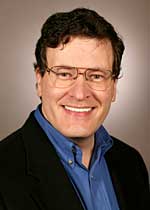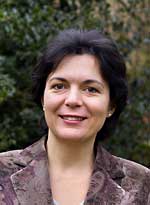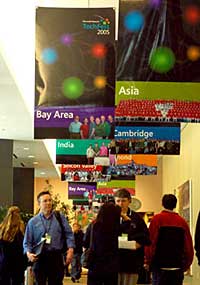REDMOND, Wash., Feb. 28, 2006 –More than 6,000 Microsoft employees will take a short break from their normal routine Wednesday and Thursday this week to visit the Microsoft Conference Center. The employees aren’t being lured with free food or lattes, rather a first glimpse at ideas and innovations that could shape the future of Microsoft products.
At the sixth-annual TechFest, hundreds of the company’s best and brightest minds will gather from Microsoft Research’s laboratories in Cambridge, England; Beijing, China; Bangalore, India; Silicon Valley, Calif.; and Redmond to offer a sneak peek at some of the projects they are working on. If all goes to plan, employees who attend this closed-door, Microsoft-only event will give feedback on the research and gain inspiration for their own projects. They also will develop relationships that will make it easier to transfer the technologies the researchers develop into Microsoft products.
“Our charter at Microsoft Research is to change the world by taking on computing’s most significant challenges,” says Rick Rashid, senior vice president for Microsoft Research. “We put few constraints on our researchers because pure research has no schedule.
“But we also realize that for this research to make a difference for our customers around world, it needs to eventually find a home in Microsoft products or inspire new products,” Rashid says. “TechFest is one of the ways we partner with the rest of the company to turn pure research into life-changing products.”
PressPass caught up with three Microsoft researchers to get their thoughts on the impact TechFest has on the company and technology at large, what it’s like to work for a world-class research organization and some of the technologies consumers might expect to see in the future. These researchers are:
-
John Platt is a Senior Researcher in the Knowledge Tools Group, where he focuses on making intelligent user interfaces and building more effective machine learning algorithms to support the interface.
-
Natasa Milic-Frayling is a Senior Researcher in the Integrated Systems group of Microsoft Research Cambridge. Her interests include design and evaluation of information retrieval systems and technologies for cross-platform and context rich communication.
-
John Krumm is a Researcher in the Adaptive Systems & Interaction Group. His work investigates techniques for measuring a person’s location and for using location data in a way that benefits the user.

John Platt, Senior Researcher, Microsoft Research Knowledge Tools Group
PressPass: How long have you been with Microsoft Research and how did you find your way here?
John Platt: I have been interested in artificial intelligence since 1982, when I went to graduate school at California Institute of Technology, where I was fortunate to study with leading computer science professors Carver Mead and John Hopfield. In 1997, I was the Director of Research at Synaptics when it struck me – 1997 was the birthday for the fictional “HAL 9000” computer in “2001: A Space Odyssey.” HAL 9000 was an autonomous AI computer, but in real life, we were still far away from the goal of autonomous artificial intelligence. I changed my research goal: instead of striving for AI, I decided I wanted to empower people to know more and make better decisions. This naturally led me to Microsoft, which makes software that helps hundreds of millions of people be more productive. I knew several computer graphics researchers at Microsoft Research who were originally from Caltech. So, in 1997, I made the jump and joined Microsoft Research to carry out my new research goal.
Natasa Milic-Frayling: My story started in 1985 when I set off from my homeland, the former Yugoslavia, to study mathematics at Carnegie Mellon University in Pittsburgh. I was in the PhD program in applied mathematics. I very much enjoyed thinking about mathematical models that explain physical phenomena. I worked on the formulation of thermodynamic laws that shape marvelous structures such as crystals. Computing gradually snuck into my life – not because I sought it, but simply because it became more accessible and served as a useful tool.
In 1998, I joined the newly opened Microsoft Research Lab in Cambridge, England. I thought how exciting it would be to live at the place that gave rise to great thinkers, like Newton, and where there is such a concentration of intellectual power and creative energy. This marked the beginning of the most productive and most rewarding part of my career and my personal life. It is a rather happy and contented moment when I converse with my children, now molded by traditional English education, switching topics between the history of British wars and the latest game design that my oldest son, now eleven, wants to implement for Xbox.
John Krumm: I’ve been a researcher with Microsoft Research a little over eight years. My PhD is not in computer science but in robotics. Before Microsoft, I was working at a national laboratory helping to make robots handle dangerous things like radioactive waste, explosives and even meat in a packing plant. Since my specialty was computer vision, I came to Microsoft Research and my first project involved using video cameras to track people in a futuristic living room. It was not that much different than tracking pieces of meat, except in the living room the meat wore clothes.
PressPass: Why do you participate in this event every year?
Platt: TechFest is tremendously exciting – hundreds of smart people come to each of our booths and engage in animated discussions, talking about implications, pointing out potential applications and limitations of our technology. It’s a good forum for feedback. It’s also a great way to stay in contact with people in the product groups with whom we’ve previously worked. For example, back in 1998, I helped to invent the filtering algorithm inside of Microsoft ClearType, a system for font display that takes advantage of the spatial structure of colors on an LCD screen to make fonts appear sharper. Every year at TechFest, I see people from the ClearType team and the Windows graphics teams. I show them what I’ve been working on, and they tell me about the latest advances in typography and graphics APIs.

Natasa Milic-Frayling, Senior Researcher, Microsoft Research (Cambridge) Integrated Systems Group
Milic-Frayling: I love participating in TechFest. It’s a rather ingenious idea. It brings us together with the product teams to experience the drive behind technology research: our desire to innovate, create and explore ideas and find ways to make an impact. I cannot think of anything else that would have the same effect and attract us to the same place at the same time.
One of my fond TechFest memories is the very first TechFest, back in 2001. We presented our MSRead prototype – an extension of Internet Explorer with a search feature that helped identify key concepts in the text while searching and browsing the Web. That was a predecessor to the Toolbar extensions that are now so common.
I was rather involved explaining how we capture thumbnails of a complete Web page and how we highlight terms on the pages when I noticed a person move closer to the demo stand. It turned out to be Bill Gates. He asked where we were going with this research and, in about 30 seconds, I spelled out my thoughts on the rich client and its importance in the distributed Web environment.
The next day I received a message from Rick Rashid asking whether I was still in town to meet with the IE product team. Attached was a message from Bill, referring to our demo, and asking the product teams to connect with us. MSRead technology and design was used by the MSN Toolbar team for the page Viewer, shipped with our first MSN Toolbar release.
Krumm: TechFest is a fun event. It’s great talking to product people face-to-face about my projects and seeing them get excited and offer ideas of how the technology can be used and improved. There’s always a pile of e-mail follow-ups with product groups to do afterwards. Since the last TechFest, I’ve worked with the Windows Live Local team to transfer a unique feature that lets users find their own location on a map using Wi-Fi access points. That’s something that I showed at a previous TechFest. This year I’ve been collaborating with another researcher and a product group to extend that work even further.
Learning about the research projects from my colleagues is fun, too. They’re always fresh and new. It’s a good place to talk about new cross-field collaborations. Just walking past the booths is awe-inspiring. I think to myself, “There’s one of the world’s experts on some technology, so maybe I’ll stop over and see what he or she has been working on lately.” Where else can you do that?
TechFest is also a big incentive for us in Microsoft Research to get our projects finished and polished. We really don’t have ship deadlines like in the product groups, but in the weeks leading up to TechFest, most of us are focused on finishing all those ideas we’ve had for months.

John Krumm, Researcher, Microsoft Research Adaptive Systems & Interaction Group
PressPass: What technologies can consumers expect to see Microsoft Research help to shape in the near future?
Krumm: We’ll see lots of new capabilities for mobile devices – cell phones, PDAs, and small PCs – because they’re getting more powerful and more connected. When you take a user away from his or her desktop PC, there are tons of new things that a mobile device can do to make life easier and more efficient. If your mobile device can infer where you are and what you’re trying to do, it can try to help you automatically by, say, showing a list of nearby restaurants around lunch time or warning you of an impending traffic jam on your way to a meeting.
At the very least, your device will be smart enough to know when to stay quiet and not be annoying. Beyond understanding your current situation, we’ll see devices that do a good job of predicting upcoming situations so they can notify you in advance of something important or wait until an opportune time to deliver information. When devices start sharing what they know about their owners – with their owner’s permission – we’ll see applications that help friends get together and that give peace-of-mind to families.
There also will be software that automatically learns your preferences after watching what you do for a while. Then when it makes a suggestion for, say, a driving route or a place to go, you’ll find it surprisingly appropriate.
Milic-Frayling: The convenience of wireless technologies will transform how people feel about computing. These technologies will be affordable and reliable, and provide completely seamless connectivity to the Web, changing how we communicate, plan and make decisions. Also, we can look forward to great information services, which can be delivered to mobile devices, tailored to people’s needs and interests and are sensitive to the person’s location.

Scene from TechFest 2005, Redmond, Wash.
Computing technologies for everyday living also will become much more pervasive. We will see our computing platform embedded in appliances that enrich our homes, schools, and public places. For example, last year at TechFest our lab demonstrated the Home Note, a flat-panel device that can receive text messages from mobile phones or be scribbled on with a stylus, and the Whereabouts clock, a prototype smart clock that helps the family communicate and inform of each other’s location. These types of technologies will proliferate and impact in other areas, as well. Technology like SenseCam, a wearable camera that can document a person’s day through photos, which was developed by Microsoft Research’s Sensors and Devices team, has been already investigated in the patient care context, helping memory impaired individuals deal with their everyday life tasks. Overall, I expect great new things across the board, and Microsoft Research to play an important role in many of these innovations.
Platt: Over the next five to 10 years, I think that the interaction between people, computers and the Internet will become much richer. Being connected to the Internet will be like having your mind augmented by the tremendous knowledge and computation power available throughout the world. Communities of people will come together to solve problems that individuals alone cannot solve. Computers will naturally provide information and entertainment to you, when you need it, rather than passively waiting for you to find it. Information on the Internet will become much more accessible and programmable, rather than being HTML files that you simply read.
PressPass: How are you going to change the world?
Platt: Margaret Mead once said, “Never doubt that a small group of thoughtful, committed citizens can change the world. Indeed, it’s the only thing that ever has.”
Krumm: The cool thing about Microsoft is that we’re working on everything from big servers to tiny wristwatches. With this breadth of involvement, my work can really push computing out into the “wild” where it hasn’t had much impact yet.
Milic-Frayling: I expect great things from the new generations. Through my research, I hope to inspire and empower the children of the world to learn, connect and reach beyond individual cultures and traditions.




